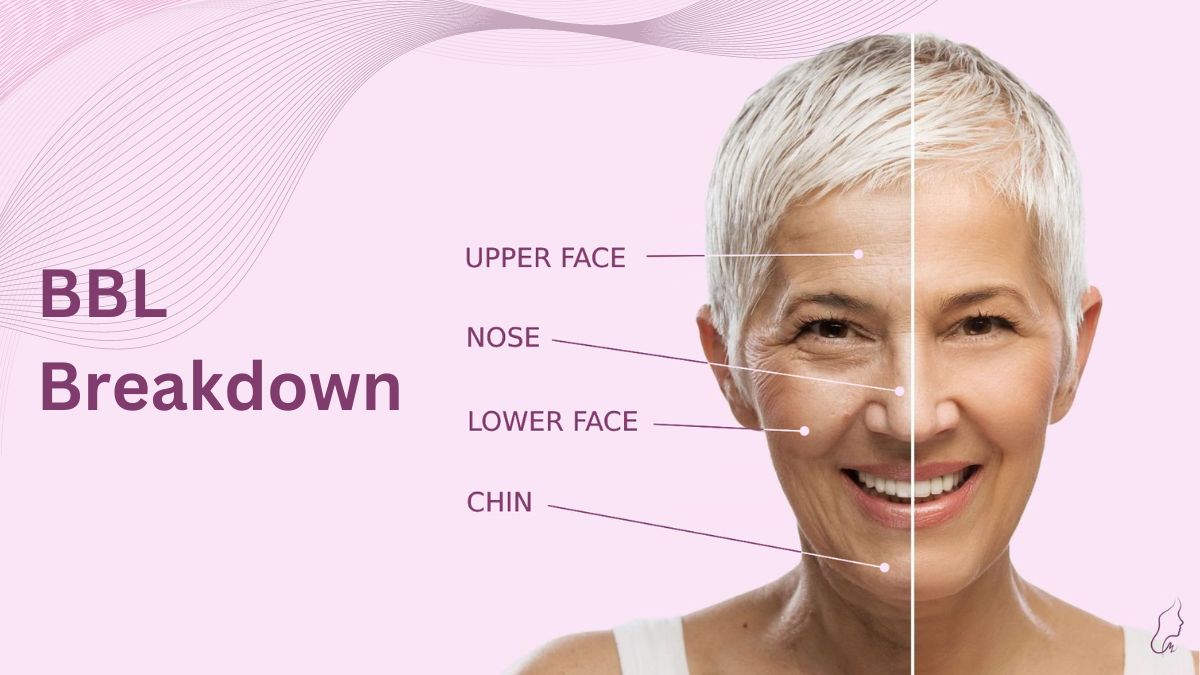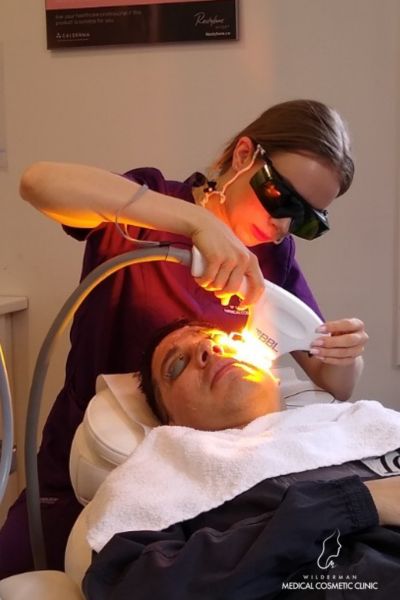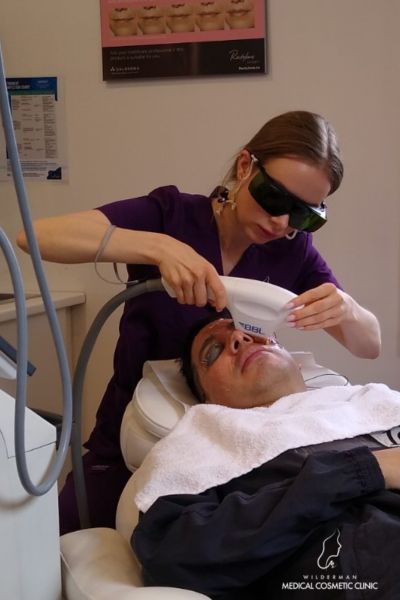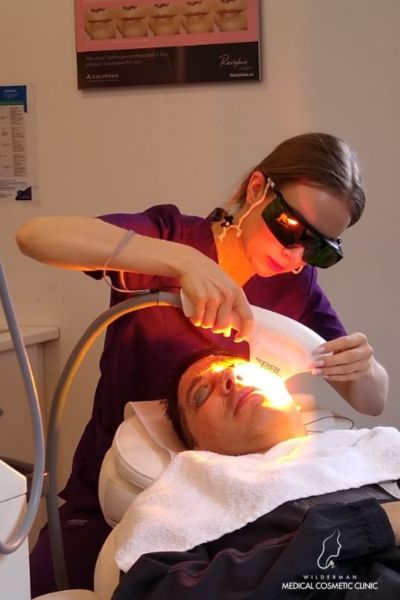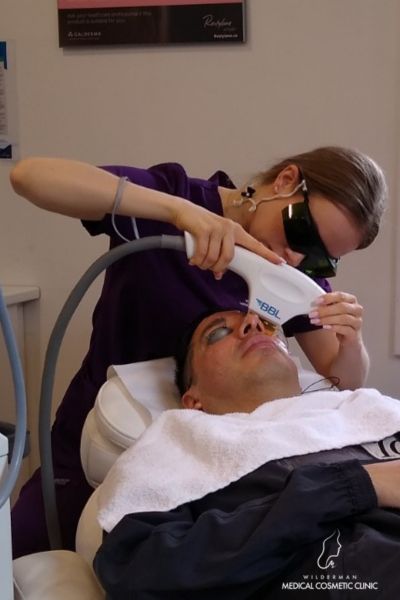What is Photorejuvenation?
Non-invasive skin treatment using light therapy for rejuvenation
This technology allows precise customization of the treatment by adjusting wavelengths and energy levels according to the specific skin condition being treated.
Photorejuvenation, also referred to as a photo facial or intense pulsed light (IPL) therapy, is a non-invasive cosmetic procedure designed to enhance the skin’s appearance.
This treatment is widely used to address various skin issues such as sun damage, age spots, redness, rosacea, broken blood vessels, and uneven skin tone. It can be performed on different areas of the body, including the face, neck, chest, and hands, to target sun damage and skin discoloration.
The procedure is relatively quick and painless, allowing patients to resume their normal activities immediately afterward.
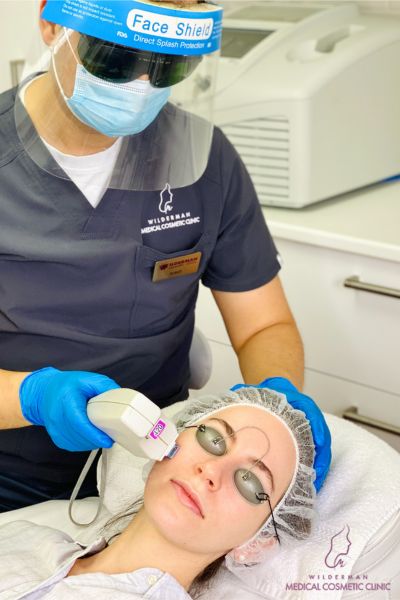
Get immediate answers to your questions about treatment options, costs, expected outcomes, and more.
- Expert Diagnosis
- Customized Treatment Plans
- No Obligation
- Comfort and Privacy
- Immediate Answers
Revolutionize Your Skin with BBL Photorejuvenation in Thornhill
Broadband light (BBL) therapy, a specific type of IPL, is employed in photorejuvenation procedures. BBL utilizes a wide range of wavelengths, enabling it to address multiple skin issues simultaneously, including sun damage, age spots, freckles, redness, and vascular lesions.
By targeting melanin, blood vessels, and other chromophores in the skin, BBL works to reduce skin discoloration and redness. Additionally, it stimulates collagen and elastin production, enhancing skin texture and reducing signs of aging.
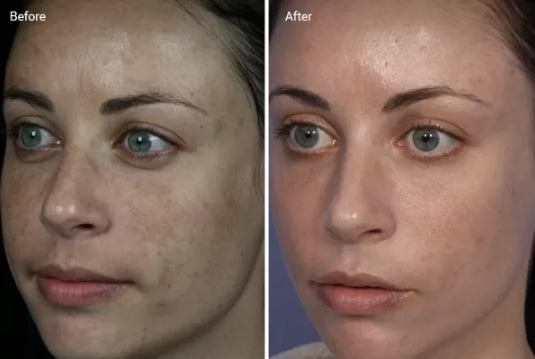
BBL photorejuvenation, like traditional IPL, is a safe and non-invasive procedure when performed by trained professionals.
BBL photorejuvenation often requires fewer sessions than traditional treatments to achieve the desired results.
Post-treatment care, including sun protection, is crucial to maintain improvements in skin appearance.
Consulting with a qualified healthcare professional is essential to determine the suitability of BBL photorejuvenation for specific skin concerns and to create a personalized treatment plan.
BBL Breakdown – Wilderman Cosmetic Clinic
Benefits of Photorejuvenation
Photorejuvenation offers several benefits for individuals seeking to improve their skin’s appearance. Some of these benefits include:
- Non-invasive: Photorejuvenation is a non-surgical and non-invasive procedure, meaning it doesn’t require incisions or anesthesia, reducing the associated risks and downtime.
- Treats multiple skin issues: It can address a wide range of skin concerns, including sun damage, pigmentation irregularities, vascular lesions, and certain types of acne scars.
- Quick and convenient: Photorejuvenation sessions are typically quick, allowing individuals to resume their regular activities immediately afterward.
- Minimal downtime: There is minimal to no downtime associated with the procedure, making it suitable for individuals with busy lifestyles.
- Safe and well-tolerated: When performed by a qualified professional, photorejuvenation is generally safe and well-tolerated, with minimal side effects.
- Boosts confidence: By improving the skin’s appearance, photorejuvenation can boost self-confidence and enhance overall well-being.
Are you a good candidate?
Although the outcomes of this treatment are appealing, it is vital to contemplate the subsequent factors that might deem you unsuitable for the procedure:
- Pregnant or breastfeeding women: Photorejuvenation procedures are generally not recommended for pregnant or breastfeeding women due to potential risks to the fetus or the baby.
- Active skin infections: Individuals with active skin infections, such as herpes or bacterial infections, should avoid these treatments to prevent the spread of infection or exacerbate the condition.
- Recent sunburn or tan: People with recent sunburn or a recent tan should delay photorejuvenation procedures. The treatment can be more effective and safer on skin that is not sunburned or tanned.
- Use of photosensitive medications: Those taking medications that make the skin more sensitive to light, like certain antibiotics or acne medications, should avoid these treatments to prevent adverse reactions.
- History of keloids or abnormal scarring: Individuals with a history of keloids or abnormal scarring might be at a higher risk of developing further complications and are generally discouraged from undergoing photorejuvenation.
- History of skin cancer: Individuals with a history of skin cancer should avoid these treatments, as the light exposure could potentially stimulate the growth of cancerous cells.
For whom would this treatment be suitable?
Photorejuvenation is a cosmetic treatment that doesn’t involve surgery or anesthesia, making it safe for most individuals with minimal risk. Individuals with the following issues can undergo this treatment.
- Sun damage
- Age spots
- Redness and rosacea
- Uneven skin tone
- Freckles
- Vascular lesions
- Fine lines and wrinkles
- Acne scars
- Enlarged pores
- Melasma
- Birthmarks
- Red or brown spots
- Dull complexion
It is important to note that the effectiveness of photorejuvenation can vary based on an individual’s skin type, the specific issue being treated, and the expertise of the healthcare professional performing the procedure.
Consultation with a qualified practitioner is essential to determine the most suitable treatment plan for individual skin concerns.
What are the precautions that need to be taken?
It is crucial to take several precautions to ensure the safety and effectiveness of the procedure. Here are the precautions that should be considered:
- Medical history disclosure: Provide your practitioner with a comprehensive medical history, including any existing medical conditions, allergies, medications, or previous cosmetic procedures.
- Skin evaluation: Have your skin evaluated by the practitioner to assess its type, condition, and specific concerns. This evaluation helps tailor the treatment plan to your individual needs.
- Avoid sun exposure: Minimize sun exposure and avoid tanning beds for at least a few weeks before the treatment. Sunburned or tanned skin is more susceptible to complications and can affect the effectiveness of the procedure.
- Avoid certain products: Stop using skincare products containing retinoids, glycolic acid, or other active ingredients for a few days before the treatment.
- Avoid blood thinners: If possible, avoid blood-thinning medications, supplements like fish oil, and herbal supplements for a specific period before the treatment.
- Follow pre-treatment instructions: Adhere to any additional pre-treatment instructions provided by your practitioner. These may include avoiding specific foods, drinks, or activities in the days leading up to the procedure.
Are there any side effects?
Yes, photorejuvenation treatments, like any medical procedure, can have potential side effects. While these effects are generally mild and temporary, it is crucial to be aware of them.
Common side effects include:
- Redness: Mild to moderate redness in the treated area is common immediately after the procedure and usually subsides within a few hours to a day.
- Swelling: Some swelling might occur, especially in delicate areas. This typically resolves within a day or two.
- Sensitivity: The treated skin might be sensitive to touch temporarily.
- Bruising: Bruising can occur, especially if you’re taking blood-thinning medications or supplements. It usually fades within a few days.
- Pigment changes: Temporary changes in skin pigmentation, either lightening or darkening of the skin, can occur. These changes usually fade over time.
- Crusting: In some cases, the treated area might form small crusts, which will heal and fall off naturally.
- Purpura: Purpura are purple-red spots that can occur after the treatment. While these usually fade within 5-7 days, they can be covered with makeup if desired.
- Infection: Although rare, infection is a possible side effect. It is essential to keep the treated area clean and follow post-treatment care instructions to minimize this risk.
- Scarring: While uncommon, there is a slight risk of scarring, especially if the treated area is not cared for properly.
- Pain or discomfort: Some patients may experience mild pain or discomfort during or after the procedure, which is usually manageable and short-lived.
- Eye injury: If the treatment is near the eyes, protective eye shields are necessary to prevent eye injury.
How does Photorejuvenation work?
Light energy targets skin issues, stimulating collagen for rejuvenation
Photorejuvenation, particularly in treatments like IPL and BBL, involves the use of intense light energy to target specific structures in the skin.
The principle behind photorejuvenation is selective photothermolysis. Specific wavelengths of light are used to target chromophores in the skin, such as melanin (responsible for pigmentation) and hemoglobin (present in blood vessels). The light energy is absorbed by these chromophores, which then convert it into heat.
The heat generated during the process stimulates the production of collagen and elastin, essential proteins that maintain skin firmness and elasticity. This collagen remodeling improves skin texture, reduces fine lines, and gives the skin a more youthful appearance.
In cases of pigmented lesions like sunspots or age spots, the light energy is absorbed by melanin, causing the pigment to fragment. Over time, the body’s natural processes eliminate these fragmented pigments, leading to a more even skin tone.
Conclusion
Photorejuvenation is a non-invasive and effective cosmetic procedure that uses light energy to address various skin concerns. By targeting specific skin issues and stimulating collagen production, photorejuvenation results in a more youthful and refreshed complexion.
It is essential to consult with a qualified healthcare professional to discuss individual needs, expectations, and potential outcomes before undergoing this treatment.
With proper precautions and personalized care, photorejuvenation can significantly improve the appearance of the skin, providing a renewed sense of confidence and well-being for patients.
Frequently Asked Questions (FAQs)
What can I expect during the treatment?
During photorejuvenation treatment:
- Preparation: Your skin will be cleansed, and protective eyewear may be provided.
- Application of gel: A cooling gel is applied to the treatment area to enhance light absorption and provide comfort.
- Light pulses: The practitioner will use a handheld device to deliver controlled pulses of light to the skin. You might feel a mild stinging or snapping sensation, similar to a rubber band flicking against the skin.
- Adjustments: The practitioner may adjust the energy levels based on your comfort and skin response.
- Session duration: Sessions typically last 20-30 minutes, depending on the treated area’s size and the specific concerns being addressed.
What can I expect after the treatment?
- Post-treatment care: After the procedure, the gel is wiped off, and cooling packs or creams might be applied to soothe the skin. You can resume normal activities immediately, although sun exposure should be avoided.
- Potential redness: Some redness and mild swelling are common immediately after the treatment, but these usually subside within a few hours to a day.
- Multiple sessions: Depending on your skin concerns, a series of sessions (usually 3-5) spaced a few weeks apart may be recommended for optimal results.
- Follow-up: Your practitioner will provide post-treatment instructions, including skincare routines and sun protection measures to maintain the results.
Is it painful?
Photorejuvenation treatments like IPL and BBL are generally well-tolerated by most patients and are considered to be minimally uncomfortable rather than painful.
During the procedure, you may feel a sensation similar to a mild snapping of a rubber band or a quick, warm prickling on the skin. Most people find the discomfort manageable and are able to tolerate it without the need for anesthesia or pain relief.
Additionally, many modern devices used for photorejuvenation treatments have built-in cooling mechanisms that help minimize discomfort and protect the skin.
However, pain tolerance varies from person to person, and the sensation can be influenced by factors such as the specific area being treated, the energy settings used, and individual pain thresholds. It’s important to discuss any concerns about discomfort with your healthcare provider beforehand, as they can adjust settings or use topical numbing agents if necessary to enhance your comfort during the procedure.
What is the recovery process like?
Here’s what you can typically expect during the recovery period:
- Immediate post-treatment period:
- Redness and swelling: Mild redness and swelling in the treated area are common and usually subside within a few hours to a day.
- Cooling sensation: Some people experience a mild cooling or tingling sensation, similar to a mild sunburn, which is normal and temporary.
- First few days after treatment:
- Avoid sun exposure: It’s crucial to avoid direct sun exposure for a few days after the procedure. If you need to go outside, wear protective clothing and use a broad-spectrum sunscreen with a high SPF.
- Gentle skincare: Use gentle skincare products and avoid harsh chemicals or exfoliants on the treated area.
- Avoid irritants: Avoid hot showers, saunas, and activities that cause excessive sweating for a day or two.
- Cool compresses: Applying cool compresses can help alleviate any discomfort or mild swelling.
- Subsequent days and weeks:
- Pigment changes: Dark spots might initially darken before gradually fading. Redness might intensify before improving. These changes are part of the natural healing process.
- Moisturize: Keep the treated area well-moisturized to support skin healing.
- Patience: Results are gradual. It might take a few weeks to see the full effects as your skin heals and new collagen forms.
- Follow-up appointments:
- Attend any scheduled follow-up appointments with your practitioner to assess the results and ensure proper healing.
- Discuss any concerns or unexpected reactions with your healthcare provider promptly.
How long do the results last?
The duration of photorejuvenation results can vary based on several factors, including the specific skin concern being treated, the individual’s skin type, lifestyle factors, and the quality of the treatment. Generally, results can last anywhere from several months to a few years.
For conditions like sunspots, redness, and uneven skin tone, the results can be long-lasting, especially with proper sun protection and skincare maintenance. However, new sun damage or other factors might cause gradual recurrence over time.
Is there any scientific research to support this treatment?
Yes, there is substantial scientific research supporting photorejuvenation treatments such as IPL (Intense Pulsed Light) and BBL (Broadband Light). Numerous studies have been conducted to evaluate the efficacy, safety, and patient satisfaction associated with these treatments (Waibel, 2009 and Kulick, 2001).
Some studies suggest that BBL technology can not only make your skin look younger but also rejuvenate it at a molecular level. This means it might have healthful benefits in treating age-related skin issues, going beyond cosmetic improvements (Chang et al.,2012).
References
Michael I. Kulick, Photorejuvenation: Using Intense Pulsed Light Technology in a Cosmetic Surgery Practice, Aesthetic Surgery Journal, Volume 21, Issue 3, May 2001, Pages 255–258, https://doi.org/10.1067/maj.2001.116243
Waibel JS. Photorejuvenation. Dermatol Clin. 2009 Oct;27(4):445-57, vi. doi: 10.1016/j.det.2009.08.007. PMID: 19850194.
Chang AL, Bitter PH Jr, Qu K, Lin M, Rapicavoli NA, Chang HY. Rejuvenation of gene expression pattern of aged human skin by broadband light treatment: a pilot study. J Invest Dermatol. 2013 Feb;133(2):394-402. doi: 10.1038/jid.2012.287. Epub 2012 Aug 30. Erratum in: J Invest Dermatol. 2013 Jun;133(6):1691. PMID: 22931923; PMCID: PMC3547222.
Toronto Dermatology Centre. (n.d.). Photorejuvenation. Retrieved from https://torontodermatologycentre.com/photorejuvenation/ (Accessed Oct 4, 2023).

